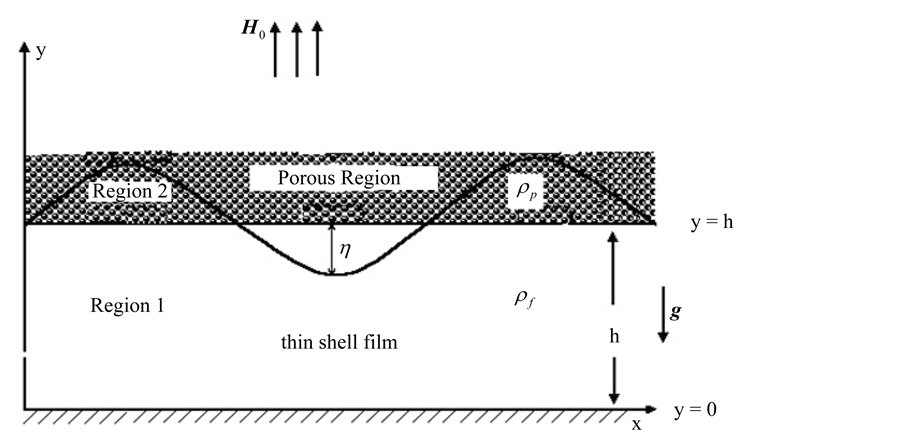Applied Mathematics
Vol.07 No.16(2016), Article ID:71598,12 pages
10.4236/am.2016.716164
Effect of Magnetic Field on Kelvin-Helmholtz Instability in a Couple-Stress Fluid Layer Bounded Above by a Porous Layer and Below by a Rigid Surface
Krishna B. Chavaraddi1*, Vishwanath B. Awati2, Nagaraj N. Katagi3, Priya M. Gouder2,4
1Department of Mathematics, S.S. Government First Grade College, Nargund, India
2Department of Mathematics, Rani Channamma University, Belgaum, India
3Department of Mathematics, Manipal Institute of Technology, Manipal, India
4K.L.E’s Dr. M. S. Sheshagiri College of Engineering and Technology, Belgaum, India

Copyright © 2016 by authors and Scientific Research Publishing Inc.
This work is licensed under the Creative Commons Attribution International License (CC BY 4.0).
http://creativecommons.org/licenses/by/4.0/



Received: April 20, 2016; Accepted: October 25, 2016; Published: October 28, 2016
ABSTRACT
Kelvin-Helmholtz instability (KHI) appears in stratified two-fluid flow at surface. When the relative velocity is higher than the critical relative velocity, the growth of waves occurs. It is found that magnetic field has a stabilization effect whereas the buoyancy force has a destabilization effect on the KHI in the presence of sharp interface. The RT instability increases with wave number and flow shear, and acts much like a KHI when destabilizing effect of sheared flow dominates. It is shown that both of ablation velocity and magnetic field have stabilization effect on RT instability in the presence of continued interface. In this paper, we study the effect of magnetic field on Kelvin-Helmholtz instability (KHI) in a Couple-stress fluid layer above by a porous layer and below by a rigid surface. A simple theory based on fully developed flow approximations is used to derive the dispersion relation for the growth rate of KHI. We replace the effect of boundary layer with Beavers and Joseph slip condition at the rigid surface. The dispersion relation is derived using suitable boundary and surface conditions and results are discussed graphically. The stabilization effect of magnetic field takes place for whole waveband and becomes more significant for the short wavelength. The growth rate decreases as the density scale length increases. The stabilization effect of magnetic field is more significant for the short density scale length.
Keywords:
KHI, Magnetic Field, Couple-Stress Fluid Layer, BJ-Slip Condition, Porous Layer, Dispersion Relation

1. Introduction
Kelvin-Helmholtz instability is one of the basic instabilities of two-fluid systems, which affects an interface. The prototypical case is that with one layer of lighter fluid overlying another of denser fluid, and the two moving horizontally in the same direction but with different velocities.
It is not uncommon for environmental fluids to be subject simultaneously to the destabilizing effect of a velocity shear and the stabilizing effect of density stratification, and, when such competition occurs, the outcome is often the so-called Kelvin-Helmholtz (KH) instability [1] . Ever since von Helmholtz [2] and Kelvin [3] developed the theory, this instability has become a standard staple of fluid mechanics, and the basic theory can be found in numerous textbooks, for example Lamb ( [4] , pp. 373-374), Turner ( [5] , pp. 93-96), Kundu ( [6] , pp. 373-381) and Scorer ( [7] , pp. 231-234) to cite a few up to the present time. Investigations into the details of the instability, including secondary instabilities [8] have been carried out perhaps with far more depth than for any other type of fluid instability.
The importance of the Kelvin-Helmholtz (KH) instability of parallel flows in laboratory, geophysical, or astrophysical systems, recognized many years ago, has generated a huge literature. The study of the Kelvin-Helmholtz instability has a long history in hydrodynamics, The basic linear stability analysis of the magnetohydrodynamvic (MHD) K-H instability was carried out long ago (Chandrasekhar [8] ). There is now also a growing literature of the nonlinear evolution of the MHD K-H instability beginning from a variety of possible initial Ñow configurations, at least in the earlier evolution stages in two dimensions. Strong magnetic fields, through their tension, are well known to stabilize the K-H instability. However, the considerable potential for much weaker fields to modify the nonlinear instability and, in particular, to reorganize the subsequent flow has only recently been emphasized.
Malik and Singh [9] investigated the nonlinear Kelvin-Helmholtz properties of (2 + 1) dimensional wave packets propagating at the interface of two superposed Ferrofluids. They considered that the fluids as moving with uniform speeds parallel to the common interface and subjected to a tangential magnetic field. They derived a nonlinear equation which governs the evolution of the amplitude of the system. The effect of a time- dependent acceleration in the presence of a tangential magnetic field on the nonlinear Kelvin-Helmholtz instability has been discussed by El-Dib [10] . El-Sayed [11] investigated the RTI problem of rotating stratified conducting fluid layer through porous medium in the presence of an inhomogenous magnetic field. This problem corresponds physically (in astrophysics) to the RTI of an equatorial section of a planetary magnetosphere or of stellar atmosphere when rotation and magnetic field are perpendicular to gravity. The KHI of two superposed viscous fluids in a uniform vertical magnetic field is discussed in the presence of effects of surface tension and permeability of porous medium by Bhatia and Sharma [12] . Following Babchin et al., [13] and Rudraiah et al., [14] , a simple theory based on Stokes and lubrication approximations is used in this study with the primary objective of using porous layer to suppress the growth rate of KHI.
In the above studies the fluid has been considered to be Newtonian. In the recent years a great deal of interest has been focused on the understanding of the couple stress effects occurring in the flow of non-Newtonian fluids through porous media. This problem appears to be, at this time, of special interest in oil reservoir engineering, where an increasing interest is being shown in the possibility of improving oil recovery efficiency from water flooding projects through mobility control with non-Newtonian displacing fluids. Consequently, it has become essential to have an adequate understanding of the couple stress effect of non-Newtonian displacing and displaced fluids in an oil displacement mechanism. Many technological processes involve the parallel flow of fluids of different viscosity, elasticity and density through porous media. Such flows exist in packed bed reactors in the chemical industry, petroleum engineering, boiling in porous media and in many other processes. Should the interface between the two fluids become unstable, a substantial increase in the resistance to the flow will result. This increase in resistance, in turn, may cause flooding in counter current packed chemical reactors and dry out in boiling porous media. In the same vein, in petroleum production engineering, such instabilities lead to emulsion formation. Hence, the knowledge of the conditions for the onset of instability will enable us to predict the limiting operation conditions of the above processes.
El-Dib and Matoog [15] have studied the Electrorheological Kelvin-Helmholtz instability of a fluid sheet. This work deals with the gravitational stability of an electrified Maxwellian fluid sheet shearing under the influence of a vertical periodic electric field. The field produces surface charges on the interfaces of the fluid sheet. Due to the rather complicated nature of the problem a mathematical simplification is considered where the weak effects of viscoelastic fluids are taken into account. The effect of boundary roughness on Kelvin-Helmholtz instability in Couple stress fluid layer bounded above by a porous layer and below by rigid surface is studied by Chavaraddi et al., [16] . Recently, they [17] have observed the effect of surface roughness on Kelvin-Helmholtz instability in presence of magnetic field. The objective of this paper is to study the effect of magnetic field on Kelvin-Helmholtz discontinuity between two couple-stress viscous conducting fluids in a transverse magnetic field through a porous medium in the presence of the effects of surface tension at the interface.
The paper is organized as follows. The basic equations are established in Section 2 together with Maxwell’s equations. The basic equations are simplified and non-dimen- sionalized using the following Stokes and lubrication approximations in this section. The resulting dispersion relation is derived using suitable boundary and surface conditions in Section 3. The cutoff and maximum wave numbers and the corresponding maximum growth rate are also obtained in Section 3. The results are discussed in Section 4 and some important conclusions are drawn in final section of this paper.
2. Mathematical Formulation
The physical configuration is shown in Figure 1. We consider a thin target shell in the form of a thin film of unperturbed thickness h (Region 1) filled with an incompressible, viscous, poorly electrically conducting light fluid of density  bounded below by a rigid surface at y = 0 and above by an incompressible, viscous poorly conducting heavy fluid of density
bounded below by a rigid surface at y = 0 and above by an incompressible, viscous poorly conducting heavy fluid of density  saturating a dense porous layer of large extent compared to the shell thickness h. The co-ordinates x and y spans the horizontal and vertical directions. The interfacial
saturating a dense porous layer of large extent compared to the shell thickness h. The co-ordinates x and y spans the horizontal and vertical directions. The interfacial  is denoted by
is denoted by . When the interface is flat then
. When the interface is flat then  when
when . The fluid velocity vector
. The fluid velocity vector  and the fluid is assumed to be non-Newtonian (couple-stress fluid), viscous electrically conducting and incompressible. The viscosity of fluid (porous medium) is given by
and the fluid is assumed to be non-Newtonian (couple-stress fluid), viscous electrically conducting and incompressible. The viscosity of fluid (porous medium) is given by ,
,  the porous parameter,
the porous parameter,  the permeability of the porous medium and
the permeability of the porous medium and  is the slip parameter at the interface. The stress gradient
is the slip parameter at the interface. The stress gradient  is related to the gravitational acceleration through the relation
is related to the gravitational acceleration through the relation . The perturbed interface
. The perturbed interface  is along the y direction.
is along the y direction.
The basic equations for clear fluid layer (region 1) and those for porous layer (region 2) are as given below:
Region-1:
 (2.2)
(2.2)
Maxwell’s Equations:
 (2.3)
(2.3)
and the auxiliary equations
Figure 1. Physical configuration.
 (2.4)
(2.4)
Region-2:

where 











The basic equations are simplified using the following Stokes and lubrication and electrohydrodynamic approximations (See Rudraiah et al. [14] ):
1) The electrical conductivity of the liquid, s, is negligibly small, i.e.,
2) The film thickness h is much smaller than the thickness H of the dense fluid above the film. That is
3) The surface elevation h is assumed to be small compared to film thickness h. That is
4) The Strauhal number S, a measure of the local acceleration to inertial acceleration in Equation (2.2), is negligibly small.
That is
where 



Under these approximations Equations (2.1) and (2.2) for fluid in the film, after making dimensionless using

become (after neglecting the asterisks for simplicity).
Region 1:



where 

mann number.
Region 2:

where 
3. Dispersion Relation
To find the dispersion relation, first we have to find the velocity distribution from Equation (2.8) using the following boundary and surface conditions:


where


Here 

The solution of (2.8) subject to the above conditions is

where
After integrating Equation (2.7) with respect to y between y = 0 and 1 and using Equation (3.5), we get

where

Then Equation (3.3), using Equations (3.6) and (3.4), becomes

To investigate the growth rate, n, of the periodic perturbation of the interface, we look for the solution of Equation (3.7) in the form

where 

Substituting Equation (3.8) into (3.7), we obtain the dispersion relation in the form

where
Also, Equation (3.9) can be expressed as

where



Setting n = 0 in Equation (3.9), we obtain the cut-off wavenumber, 

because 

The maximum wavenumber, 


because 

The corresponding maximum growth rate, nm, is

Similarly, using

and hence

The growth rate given by Equation (3.9) is computed numerically for different values of parameters and the results are presented graphically in Figures 2-5.
Figure 2. Growth rate, n versus the wavenumber, 


Figure 3. Growth rate, n versus the wavenumber, 



Figure 4. Growth rate, n versus the wavenumber, 


Figure 5. Growth rate, n versus the wavenumber, 



4. Results and Discussion
In this study we have shown the effect of physical parameters involved in the problem on effect of magnetic field on surface instability of KH type in a couple- stress fluid layers bounded above by a porous layer and below by a rigid boundary. Numerical calculations were performed to determine the growth rate at different wavenumbers for various fluid properties like couple stress parameter M0, Hartmann number M, Bond number B and porous parameter
We have investigated the role of the magnetic field on the two-layer channel flow problem, demonstrated that either destabilization or stabilization can be obtained and presented growth rates in situations where the magnetic field is stabilizing over a broad range of wavenumbers for increasing in Hartmann number M in Figure 3 where 

Also, when fix all the input parameters we find that the higher the couple-stress parameter the more stable the interface is. In Figure 2, we have plotted the growth rate against the wavenumber in the case where 

In addition, we have investigated the effect of the surface tension of the fluid on the instability of the interface. In our sample calculations, we have taken



However, in order to understand the effect of the porous properties on the instability, we now fix values of other parameters




5. Conclusions
Kelvin-Helmholtz instability is one of the basic mechanisms, which influence the two-phase flow. When relative velocity is larger than the critical velocity, the instability occurs. With instability, flow regime is changed, and also interface surface is significant enlarged, which influence the heat and mass transfer. With linearised Navier-Stokes equations we can analytically predict onset of instability and wavelength for inviscid flow.
We have studied the linear stability of a two-fluid flow in a channel where the fluids are assumed to be Newtonian with different fluid properties (Hartmann number, couple-stress ratio, Surface tension and porous parameter) and subjected to magnetic field normal to their interface. For this purpose, we have derived and then linearized the equations of motion where the interaction between the hydrodynamic and couple- stress problems occurs through the stress balance at the fluid interface. The growth rate of the perturbation was then computed by using the normal mode method and its variation studied as a function of the dimensionless parameter Hartmann number M, couple-stress parameter M0, as well as Bond number B and porous parameter
Acknowledgements
This work is supported by the VGST, Department of Science & Technology, Government of Karnataka under grant no. VGST/SMYSR(2014-15)/GRD-433/2015-16, Dated : 28.04.2015 and the authors (NNK, VBA and PMG) wishes to thank respectively the Director/VC/Principal of their institutions for their encouragement and support in doing research.
Cite this paper
Chavaraddi, K.B., Awati, V.B., Katagi, N.N. and Gouder, P.M. (2016) Effect of Magnetic Field on Kelvin- Helmholtz Instability in a Couple-Stress Fluid Layer Bounded Above by a Porous Layer and Below by a Rigid Surface. Applied Mathematics, 7, 2021-2032. http://dx.doi.org/10.4236/am.2016.716164
References
- 1. De Silva, I.P.D., Fernando, H.J.S., Eaton, F. and Hebert, D. (1996) Evolution of Kelvin-Helmholtz Billows in Nature and Laboratory. Earth and Planetary Science Letters, 143, 217-231.
http://dx.doi.org/10.1016/0012-821X(96)00129-X - 2. Von Helmholtz, H.L.F. (1868) Uber discontinuierliche Flüssigkeitsbewegungen. Monatsberichte der k?nigl. Akad. der Wissenschaften zu Berlin, 215-228.�
- 3. Kelvin, L. (1871) Hydrokinetic Solutions and Observations. Philadelphia Magazine, 10, 155-168.
- 4. Lamb, H. (1945) Hydrodynamics. 6th Edition, Dover Publications, New York, 738 p.
- 5. Turner, J.S. (1973) Buoyancy Effects in Fluids. Cambridge University Press, Cambridge, 368 p.
http://dx.doi.org/10.1017/CBO9780511608827 - 6. Kundu, P.K. (1990) Fluid Mechanics. Academic Press, Cambridge, 638 p.
- 7. Scorer, R.S. (1997) Dynamics of Meteorology and Climate. John Wiley & Sons, Hoboken, 686 p.
- 8. Chandrasekhar, S. (1961) Hydrodynamic and Hydromagnetic Stability. Oxford University Press, New York.
- 9. Malik, S.K. and Singh, M. (1988) Nonlinear Focusing and the Kelvin-Helmholtz Instability in Ferrofluid/Nonmagnetic Fluid Systems. Physics of Fluids, 31, 1069.
http://dx.doi.org/10.1063/1.867018 - 10. El-Dib, Y.O. (1996) Nonlinear Stability of Kelvin-Helmholtz Waves in Magnetic Fluids Stressed by a Time-Dependent Acceleration and a Tangential Magnetic Field. Journal of Plasma Physics, 55, 219.
http://dx.doi.org/10.1017/S0022377800018808 - 11. El-Sayed, M.F. (2002) Effect of Variable Magnetic Field on the Stability of a Stratified Rotating Fluid Layer in Porous Medium. Czechoslovak Journal of Physics, 50, 607.
http://dx.doi.org/10.1023/A:1022854217365 - 12. Bhatia, P.K. and Sharma, A. (2003) KHI of Two Viscous Superposed Conducting Fluids. Proceedings of the National Academy of Sciences, India, 73, 497.
- 13. Babchin, A.J., Frenkel, A.L., Levich, B.G. and Shivashinsky, G.I. (1983) Nonlinear Saturation of Rayleigh-Taylor Instability in Thin Films. Physics of Fluids, 26, 3159.
http://dx.doi.org/10.1063/1.864083 - 14. Rudraiah, N., Mathad, R.D. and Betigeri, H. (1997) The RTI of Viscous Fluid Layer with Viscosity Stratification. Current Science, 72, 391.
- 15. El-Dib, Y.O. and Matoog, R.T. (2005) Electrorheological Kelvin-Helmholtz Instability of a Fluid Sheet. Journal of Colloid and Interface Science, 289, 223-241.
http://dx.doi.org/10.1016/j.jcis.2005.03.054 - 16. Chavaraddi, K.B., Awati, V.B. and Gouder, P.M. (2015) Effect of Surface Roughness on Kelvin-Helmholtz Instability in Presence of Magnetic Field. International Journal of Engineering Sciences & Research Technology (IJESRT), 4, 525-534.
- 17. Chavaraddi, K.B., Katagi, N.N., Awati, V.B. and Gouder, P.M. (2014) Effect of Boundary Roughness on Kelvin-Helmholtz Instability in Couple Stress Fluid Layer Bounded Above by a Porous Layer and Below by Rigid Surface. International Journal of Computational Engineering Research, 4, 35-43.













